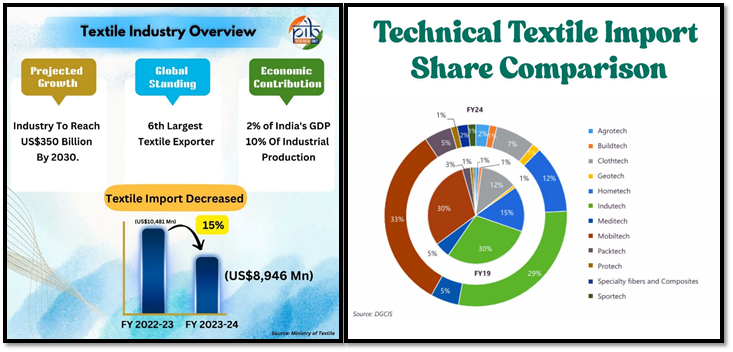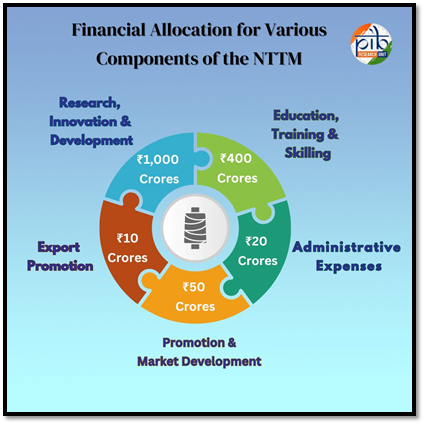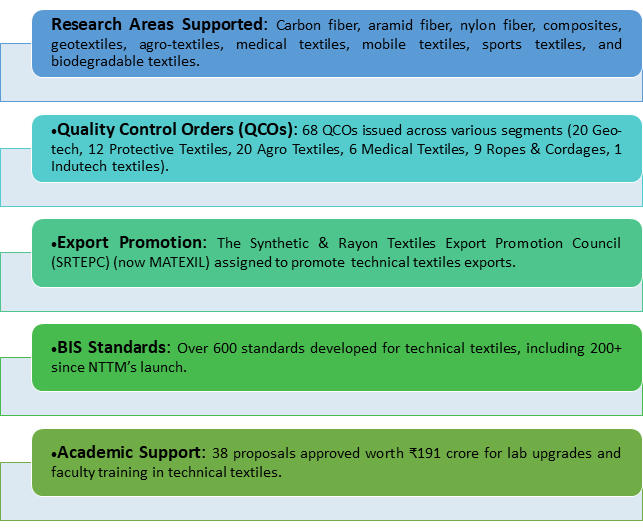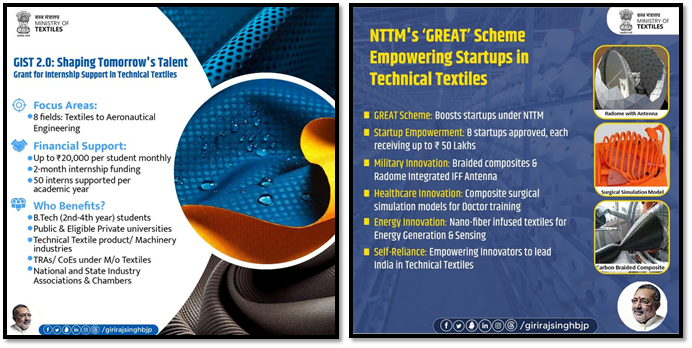India’s textile industry is important to the economy and makes some of the most innovative fabrics globally. India is the 6th largest exporter of textiles globally, with a 3.9% share in world textile exports. It contributes nearly 2% to the country’s GDP. The sector is set to grow to US$350 billion by 2030 further strengthening India’s position in the global market. This growth is expected to create 3.5 crore jobs.

While traditional textiles remain crucial, the rise of technical textiles is reshaping the industry. These are specialized fabrics designed for specific uses, focusing on function over appearance. They are divided into 12 categories, each serving a different purpose.
|
Technical textiles are fabrics made for specific functions and performance, rather than for looks. These textiles are designed to meet the needs of various industries like cars, construction, farming, healthcare, and safety. They are used in products that help protect people, improve machinery, and solve practical problems, such as in car parts, building materials, medical equipment, and safety gear. |

Framework for the National Technical Textiles Mission
With a view to boost technical textiles sector in the country, National Technical Textiles Mission (NTTM) was launched for a period from 2020-21 to 2025-26 with an outlay of Rs.1,480 crores. The National Technical Textiles Mission (NTTM) focuses on using textiles in key areas. The National Technical Textiles Mission (NTTM) has four key components aimed at boosting the sector’s growth:
- Component I – Research, Innovation and Development: Supports R&D in technical textiles, inviting proposals to develop new materials and processes.
- Component II – Promotion and Market Development: Aims to increase technical textile adoption in India through market promotion and international collaborations.
- Component III – Export Promotion: Focuses on boosting exports of technical textiles with a dedicated export council. Outlay
- Component IV – Education, Training, and Skill Development: Promotes technical textiles education, skill training, and internships in top institutes and industries.
₹517 crore has been allocated for the National Technical Textiles Mission (NTTM) since its launch. So far, ₹393.39 crore has been used for various activities such as research, innovation, market development, export promotion and skill development in technical textiles. A total of 168 research projects, valued at around ₹509 crore, have been approved under NTTM.

NTTM Key Highlights

NTTM Strengthening the Textile Industry with Other Initiatives
The National Technical Textiles Mission (NTTM) is driving the transformation of India’s textile sector with a range of initiatives focused on innovation, skill development and promoting indigenous production.

- Grant for Internship Support for Technical Textiles (GIST 2.0): Launched under NTTM, GIST 2.0 bridges the gap between industry and academia by offering hands-on learning opportunities in technical textiles. It fosters local innovation, supports the Make in India initiative and helps empower young talent to drive growth in the textile sector.
- Grant for Research & Entrepreneurship across Aspiring Innovators in Technical Textiles (GREAT) Scheme: Launched in August 2023, the program provides funding to help translate prototypes into technologies and products for commercialization. So far, 8 startups were granted ₹50 lakh each for innovations in medical, industrial and protective textiles. Additionally, three educational institutes, including IIT Indore and NIT Patna, received ₹6.5 crore to introduce specialized courses in geotextiles, geosynthetics, and sports textiles.
- Skill Development Programs: To meet the growing demand in the technical textiles sector, NTTM aims to train 50,000 individuals, including undergraduate students, unskilled workers, and professionals. The initiative provides targeted skill development through 12 industry-focused courses developed by organizations like SITRA (South India Textiles Research Association), NITRA (Northern India Textile Research Association) and SASMIRA (South Ahmedabad Silk Mill and Industrial Research Association) in areas like medical, protective, mobile, and agricultural textiles.
- Technotex 2024: Held as part of Bharat Tex 2024, showcased the strength of India’s technical textiles sector, offering a platform to explore global investment opportunities. A highlight of the event was the Innovation Zone under the National Technical Textiles Mission (NTTM), spanning 693 square meters. This dedicated pavilion featured 71 cutting-edge projects, with 48 presented as prototypes and 23 through informative posters.

Success Stories
In the rapidly evolving textile industry, innovation is driving major advancements in both comfort and functionality. One such example is Eicher Goodearth’s launch of Mahina, India’s first bonded leak-proof period underwear. Offering superior absorbency and leak protection for up to 12 hours, Mahina is made with natural materials, ensuring comfort and safety. It lasts for up to 100 washes without the need for pads or tampons.
States are increasingly focusing on strengthening the technical textiles industry. The Tamil Nadu Budget has prioritized its growth through key initiatives, including the establishment of the PM MITRA Park in Virudhunagar and a textile park in Salem. Additionally, the budget boosts capital subsidies for technical textiles investments, increasing the subsidy for spinning modernization from 2% to 6% to reduce costs and promote machinery upgrades.


